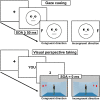From gaze cueing to perspective taking: Revisiting the claim that we automatically compute where or what other people are looking at
- PMID: 26924936
- PMCID: PMC4743615
- DOI: 10.1080/13506285.2015.1132804
From gaze cueing to perspective taking: Revisiting the claim that we automatically compute where or what other people are looking at
Abstract
Two paradigms have shown that people automatically compute what or where another person is looking at. In the visual perspective-taking paradigm, participants judge how many objects they see; whereas, in the gaze cueing paradigm, participants identify a target. Unlike in the former task, in the latter task, the influence of what or where the other person is looking at is only observed when the other person is presented alone before the task-relevant objects. We show that this discrepancy across the two paradigms is not due to differences in visual settings (Experiment 1) or available time to extract the directional information (Experiment 2), but that it is caused by how attention is deployed in response to task instructions (Experiment 3). Thus, the mere presence of another person in the field of view is not sufficient to compute where/what that person is looking at, which qualifies the claimed automaticity of such computations.
Keywords: Gaze; attentional cueing; joint attention; perspective-taking; theory of mind.
Figures





References
-
- Abbate C. S., Isgrò A., Wicklund R. A., Boca S. A field experiment on perspective-taking, helping, and self-awareness. Basic and applied social psychology. 2006;(3):283–287. doi: 10.1207/s15324834basp2803_7. - DOI
-
- Baron-Cohen S. The eye direction detector (EDD) and the shared attention mechanism (SAM): Two cases for evolutionary psychology. In: Moore C., Dunham P. J., editors. Joint attention: Its origins and role in development. Hillsdale, NJ: Lawrence Erlbaum; 1995. pp. 41–59.
-
- Bruyer R., Brysbaert M. Combining speed and accuracy in cognitive psychology: Is the inverse efficiency score (IES) a better dependent variable than the mean reaction time (RT) and the percentage of errors (PE)? Psychologica Belgica. 2011;(1):5–13. doi: 10.5334/pb-51-1-5. - DOI
-
- Driver J., Davis G., Ricciardelli P., Kidd P., Maxwell E., Baron-cohen S. Gaze perception triggers reflexive visuospatial orienting. Visual Cognition. 1999;(5):509–540. doi: 10.1080/135062899394920. - DOI
LinkOut - more resources
Full Text Sources
Other Literature Sources
